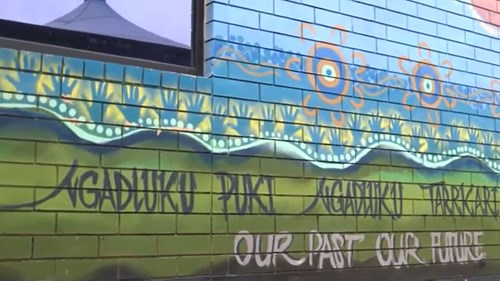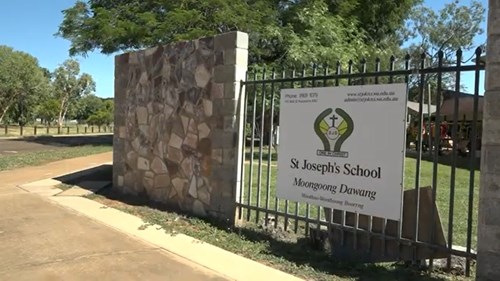Leigh Creek Area School
Introduction
Leigh Creek is situated 560kms north of Adelaide in the hot, arid zone of South Australia’s northern Flinders Ranges. Leigh Creek Area School caters to students from Foundation to Year 12 (F – 12) and is located on the traditional lands of the Adnyamathanha Peoples.
The current enrolment is 50 - 60 students, of whom approximately 80% are Aboriginal and/or Torres Strait Islander. The school experienced a decline in enrolments with the closure of the coal mine in 2016. However, a later government decision to make housing available to families has seen a modest increase.
The school has implemented an Adnyamathanha Aboriginal Language revival program in consultation with the community, Adnyamathanha Elders and the Adnyamathanha Language and Culture Committee (ALACC).The language program is timetabled for three 45-minute lessons per week for students in Foundation to Year 9 and five 45-minute lessons per week for Years 10 to 12.
Leigh Creek Area School was one of five South Australian schools to be awarded an Innovative Language Program Grant by the South Australia Department for Education. The school uses the grant to access linguists from the Mobile Language Team who support the revival program, record Adnyamathanha Language and assist in the development of resources. The school’s educators use culturally responsive teaching methods and collaborate with community in the classroom and on Country, to learn, reawaken and strengthen Adnyamathanha.
This illustration of practice demonstrates the whole school and community approach to Adnyamathanha Language and culture teaching and learning, with students from F-12 learning and engaging with Adnyamathanha Language and culture in the classroom and on Country. The album of videos is designed to be viewed in sequence. However, the titles reference the theme for each video to assist with viewing them individually:
Video 1: Welcome to Leigh Creek Area School – school context
Video 2: Teaching and Learning Adnyamathanha – teaching team perspective
Video 3: Whole school and community approach – community perspective
Video 4: Learning our Language – student voice and engagement
Video 5: Positive outcomes – benefits and challenges
Australian Institute of Aboriginal and Torres Strait Islander Studies (AIATSIS): https://aiatsis.gov.au/
Australian Curriculum Framework for Aboriginal Languages and Torres Strait Islander Languages: https://www.australiancurriculum.edu.au/f-10-curriculum/languages/framework-for-aboriginal-languages-and-torres-strait-islander-languages/
DECS/Adnyamathanha Community. 2005. Adnyamathanha Handbook. Adelaide: Department of Education and Children’s Services.
DECS. 2004. Adnyamathanha years R to 10: a teaching framework for revival and second language learning in years reception to ten. Adelaide. Dept. of Education and Children's Services. (This material is available at the State Library of South Australia and other libraries in Adelaide.)
First Languages Australia: https://www.firstlanguages.org.au/
(Includes a map of Language Centres and programs to help locate organisations in regions across Australia).
Information about the South Australia Department for Education Innovative Language Grant:
https://www.education.sa.gov.au/department/media-centre/our-news/innovative-language-grants
Leigh Creek Area School website: https://www.leighcreekas.sa.edu.au/
Mobile Language Team: https://www.mobilelanguageteam.com.au/
Tunbridge, D. 1987. Aboriginal place names. Australian Aboriginal Studies 2: pp. 2-13. (This material is available at the State Library of South Australia.)
Tunbridge, D. 1988. Flinders Ranges Dreaming. Canberra: Aboriginal Studies Press. (This material is available at the State Library of South Australia, Barr Smith and other libraries in Adelaide.)
Tunbridge, D. 1988. Affixes of motion and direction in Adnyamathanha. In Complex sentence constructions in Australian languages / edited by Peter Austin - Amsterdam; John Benjamins: pp 267-283. (This material is available at the State Library of South Australia, Barr Smith and other libraries in Adelaide.)
|
Adnyamathanha word |
English |
|
Adnyamathanha Peoples |
The Adnyamathanha Peoples are made up of several traditional groups of the Northern Flinders Ranges and areas around Lake Torrens. The name ‘Adnyamathanha’ means ‘Rock People.’ |
|
Muda |
The shared, cultural and linguistic identity and knowledge inherited from ancestors which forms a common bond. Muda is passed on in the form of creation stories from generation to generation in a long held oral tradition. The Adnyamathanha Peoples generally refer to this as History. The Muda teaches social customs and rules, explains and maps geographical knowledge, contains environmental understandings and is a focal point for community identity. |
|
Moiety |
One of two parts into which society is divided based on descent from the mother or father. In Aboriginal societies and Torres Strait Islander societies, moieties describe systems of kin relationships and behaviours between people and may also include parts of the natural world. |
|
Yura |
Adnyamathanha person |
|
Yura Ngawarla |
Adnyamathanha language (being Adnyamathanha for "our speech"). Adnyamathanha is a member of the Thura-Yura language family and the only one which still has fluent Aboriginal speakers. |
|
Udnyu |
Non-Aboriginal person |
|
Akurra |
Adnyamathanha Peoples believe the land was shaped by giant serpents of the two moieties. |
|
Arrunha Awi |
Aroona water (Dam) |
|
Yakarti |
Child/children |
|
Nhangga |
Greeting- hello, how are you? |
|
Nhaku |
Yes, that’s right |
|
ACEO |
Aboriginal Community Education Officer |
|
Reclaim, revive, renew, rebuild, reconstruct, construct, develop languages |
Terms used generally and interchangeably with respect to Aboriginal languages and Torres Strait Islander languages to refer to language processes and language programs developed in contexts of historical language loss, and located mainly in the Language Revival Learner Pathway (LR). In the Framework, revive, revitalise, renew and reclaim take on particular language and program activity meanings. |
|
Language Revival |
A planned response designed to counter histories of language loss. Aboriginal languages and Torres Strait Islander languages are being revived through community initiatives, school programs and linguistic research. |
In the illustration of practice:
What are the goals of the Adnyamathanha Language program?
How did the school identify and engage with a range of stakeholders in the development of their language program?
What are the benefits of the language program for the students, school and community?
How is the school using and adapting the AC: Aboriginal Languages and Torres Strait Islander Languages Framework in their planning and implementation?
Why is learning on Country important?
How does the school cater for all learners?
In your school context:
How could you implement an Aboriginal Languages or Torres Strait Islander Languages program in your context?
Which Curriculum pathway (LR, L1, L2) would be the most appropriate for your school and community context?
What requirements would the school and the community need to negotiate? How would the consultation and engagement processes establish the foundation for the language program?
Identify how an Aboriginal Languages or Torres Strait Islander Languages program would benefit your students, school and community.
Identify a process to review the initial program goals and measure growth and success.
ACARA acknowledges that the filming for this illustration of practice took place on the traditional land, sea, sky and waterways of the Adnyamathanha Peoples.
Aboriginal and Torres Strait Islander viewers are warned that the videos in this Illustration of Practice may contain images and voices of deceased persons.
ACARA would like to thank:
- The Adnyamathanha Community and Elders from Leigh Creek, Copley and Nepabunna
- Leigh Creek Area School
- The Leigh Creek Community
- Aunty Gladys Wilton and Aunty Linda Coulthard for the soundtrack contribution
- The Mobile Language Team for providing the drone footage
- The Commonwealth Government for funding this Illustration of Practice through the Endeavour Language Teachers Fellowship

